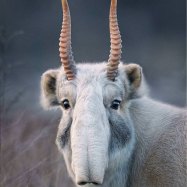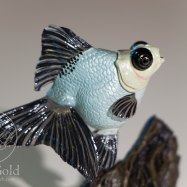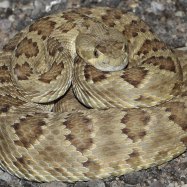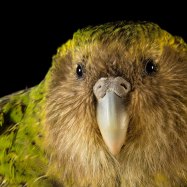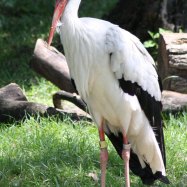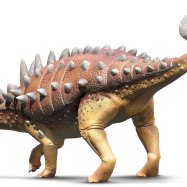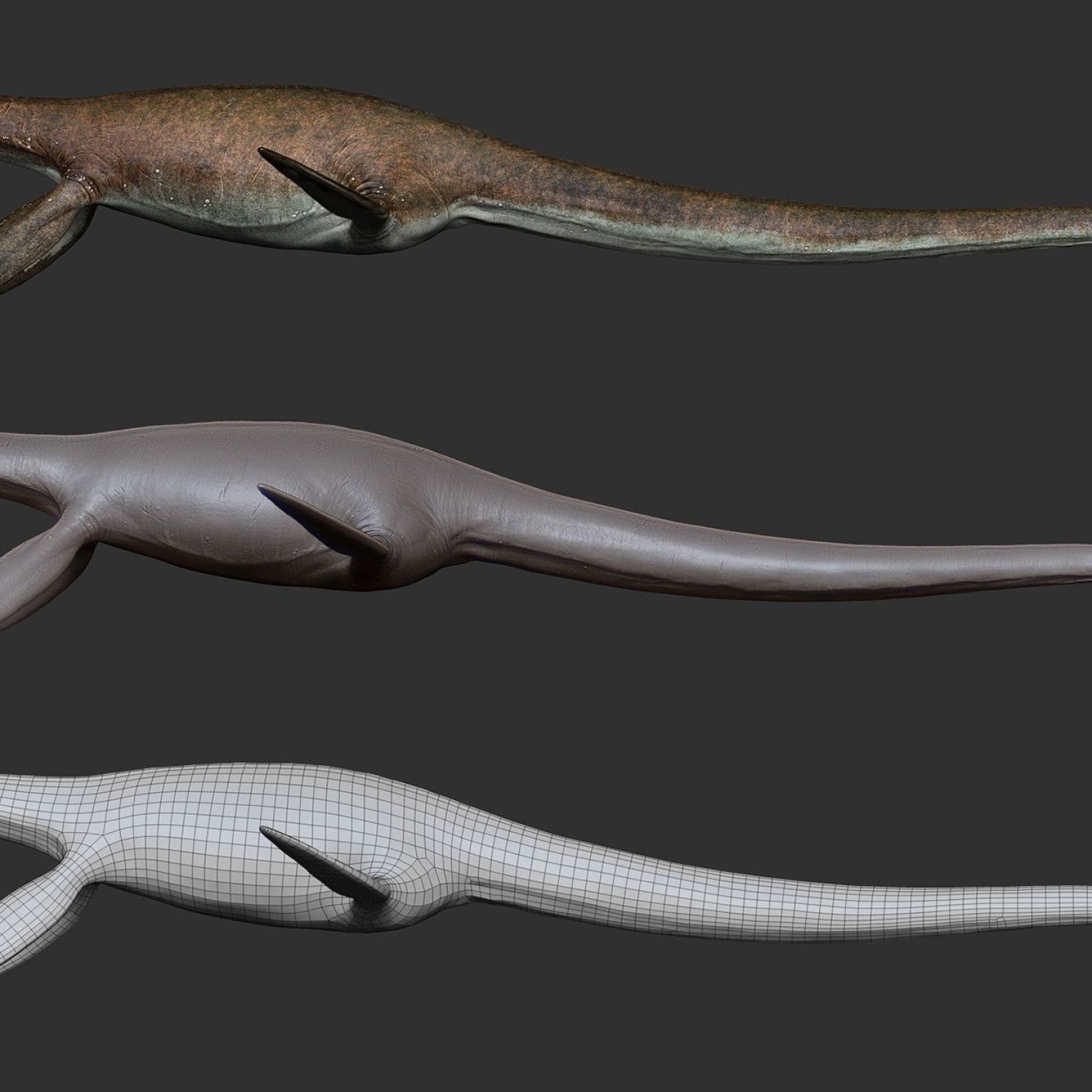
Thalassomedon
Up to 10 meters
Thalassomedon, a member of the Plesiosauridae family, roamed the Western Interior Seaway over 80 million years ago. Known for its long and slender body, this sea reptile could grow up to 10 meters in length. Today, its fossil remains continue to fascinate and educate us about prehistoric marine life. #Thalassomedon #Plesiosauridae #prehistoricanimals
Animal Details Summary:
Common Name: Thalassomedon
Kingdom: Animalia
Habitat: Marine
The Majestic Thalassomedon: A Look into the Fascinating World of a Plesiosaur
Under the depths of the Western Interior Seaway of North America, lived a creature that would eventually capture the imagination of scientists and fossil enthusiasts alike. This creature is none other than the Thalassomedon, a prehistoric sea creature that roamed the oceans during the Late Cretaceous period. Let us dive deeper into the fascinating world of this magnificent creature.Exploring the Taxonomy of Thalassomedon
Scientifically known as Thalassomedon, this marine animal belongs to the kingdom Animalia, the phylum Chordata, and the class Reptilia Thalassomedon. It is part of the order Plesiosauria and the family Plesiosauridae, which includes some of the most famous prehistoric sea creatures such as the Elasmosaurus and the Cryptoclidus.The Habitat and Geographical Distribution of Thalassomedon
As mentioned earlier, Thalassomedon was a marine animal, meaning it lived in the ocean. Its habitat was the Western Interior Seaway, a vast body of water that stretched from the present-day Arctic Ocean to the Gulf of Mexico during the Late Cretaceous period. This seaway divided the North American continent in two, providing a rich and diverse environment for marine animals to thrive.Thalassomedon, specifically, had a wide geographical distribution, with fossils being discovered in North America, specifically in the United States, particularly in the state of Kansas. However, it is believed that this creature could have roamed other parts of the seaway as well.
The Feeding Method of Thalassomedon
Being a plesiosaur, Thalassomedon was a carnivorous creature, meaning it preyed on other animals for survival. Its long slender body and streamlined shape were adapted for swift movements in the water, making it a proficient hunter. Its diet likely consisted of small fish and other marine creatures, which it caught using its sharp conical teeth Tamaskan.A Look at the Physical Characteristics of Thalassomedon
Since Thalassomedon lived in the depths of the ocean and fossils do not preserve color, the animal's coloration is still unknown. However, we can make assumptions based on the color patterns of its closest relatives, such as the Elasmosaurus, which was believed to have a dark-colored back and a lighter underside.In terms of physical appearance, Thalassomedon had a long and slender body, with four flippers, and a small head with a pointed snout. The length of this creature's body could reach up to 10 meters, making it one of the largest known plesiosaurs. Its body shape and flippers allowed it to be an efficient swimmer, propelling itself through the water with great speed and agility.
Thalassomedon's Place in the Ecosystem
During the Late Cretaceous period, the Western Interior Seaway was teeming with life. A diverse range of marine animals could be found in its waters, from small fish to giant mosasaurs. In this ecosystem, Thalassomedon played an important role as a predator, balancing the population of its prey and contributing to the overall health of the environment.Not only that, but Thalassomedon's fossils also serve as an important feature in the study of paleontology, providing information on the evolution, behavior, and ecology of prehistoric sea creatures.
Discovering Thalassomedon's Fossil Record
The first Thalassomedon fossil was discovered by paleontologist Samuel W. Williston in 1890 in western Kansas. This fossil was a nearly complete skeleton, making it an essential specimen in the study of plesiosaurs.Since then, more fossil discoveries have been made, with numerous skeletons of Thalassomedon being excavated from various parts of the Western Interior Seaway. These fossils include not only complete skeletons but also isolated bones, teeth, and even stomach contents, providing a wealth of knowledge about this creature's life.
The Evolution of Plesiosaurs
Plesiosaurs were a diverse group of prehistoric marine reptiles that existed during the Mesozoic era. They are often depicted as straight-necked "sea monsters" with long bodies and four flippers, but in reality, they came in a variety of shapes and sizes.Plesiosaurs evolved from a group of land-dwelling reptiles known as the nothosaurs, during the Triassic period. Thalassomedon, being a plesiosaur, belongs to the subgroup known as the "plesiosaurs proper," which had longer necks and smaller heads compared to other plesiosaurs like the Elasmosaurus.
In Conclusion
The Thalassomedon, with its long and slender body and sharp teeth, was an apex predator of the Western Interior Seaway, adapting to thrive in its underwater environment. Its fossils provide us with valuable information on the biology and ecology of prehistoric sea creatures, giving us a glimpse into the diverse and vibrant ecosystem of the Late Cretaceous period.As we continue to unearth more fossils and learn more about Thalassomedon and other plesiosaurs, one can only wonder about the mysteries that still lie beneath the surface of the Western Interior Seaway and the world of these magnificent creatures.

Thalassomedon
Animal Details Thalassomedon - Scientific Name: Thalassomedon
- Category: Animals T
- Scientific Name: Thalassomedon
- Common Name: Thalassomedon
- Kingdom: Animalia
- Phylum: Chordata
- Class: Reptilia
- Order: Plesiosauria
- Family: Plesiosauridae
- Habitat: Marine
- Feeding Method: Carnivorous
- Geographical Distribution: North America
- Country of Origin: United States (Kansas)
- Location: Western Interior Seaway
- Animal Coloration: Unknown
- Body Shape: Long and slender
- Length: Up to 10 meters
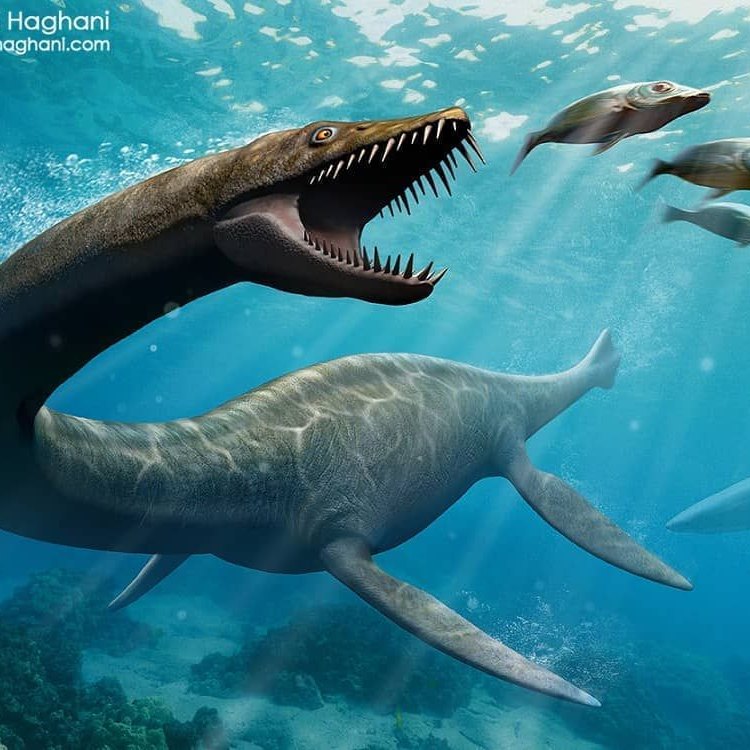
Thalassomedon
- Adult Size: Unknown
- Average Lifespan: Unknown
- Reproduction: Unknown
- Reproductive Behavior: Unknown
- Sound or Call: Unknown
- Migration Pattern: Unknown
- Social Groups: Unknown
- Behavior: Unknown
- Threats: Extinction
- Conservation Status: Extinct
- Impact on Ecosystem: Unknown
- Human Use: None
- Distinctive Features: Long neck and paddle-like flippers
- Interesting Facts: Thalassomedon was a large marine reptile that lived during the Late Cretaceous period.
- Predator: Unknown
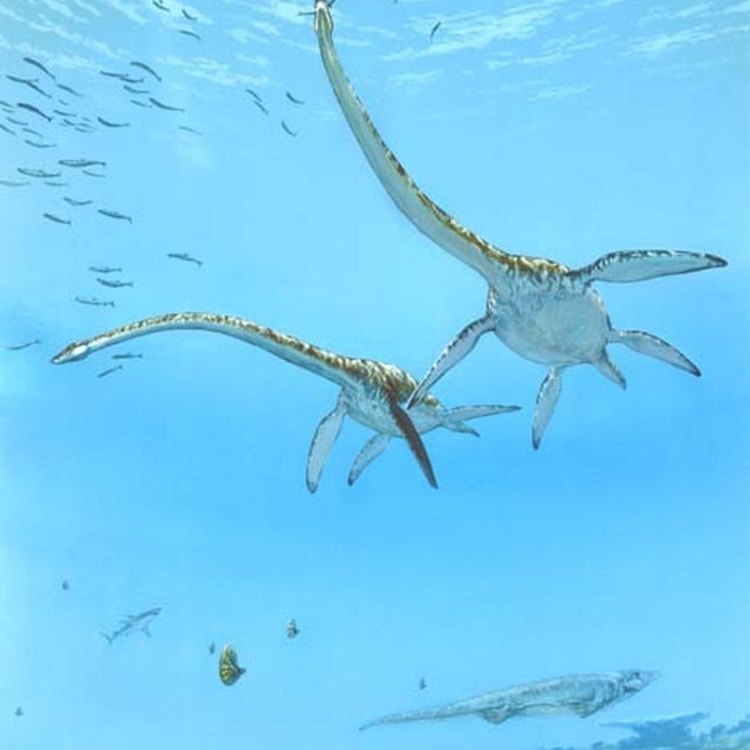
Thalassomedon
The Mysterious Thalassomedon: A Fascinating Sea Monster of the Late Cretaceous
The Late Cretaceous period, approximately 85 million years ago, was a time of great diversity and abundance of marine creatures. Among these prehistoric sea creatures was a fascinating reptile known as Thalassomedon. This unique creature remains shrouded in mystery, with much of its information still unknown to scientists. In this article, we will dive deep into the world of Thalassomedon, exploring its distinctive features, interesting facts, and the impact it may have had on the ecosystem PeaceOfAnimals.Com.Uncovering the Unknown
Despite extensive research, little is known about Thalassomedon, including its adult size, average lifespan, reproduction, reproductive behavior, sound or call, migration pattern, and social groups. Scientists can only make speculations based on limited evidence, making Thalassomedon one of the most enigmatic creatures to have ever roamed the seas.One of the reasons for this lack of information is the rarity of Thalassomedon fossils. So far, only a few fossils have been found, making it challenging for scientists to understand this prehistoric creature fully. However, what we do know is that Thalassomedon was a large marine reptile that lived during the Late Cretaceous period.
The Distinctive Features of Thalassomedon
Despite the lack of information, there are a few distinctive features that make Thalassomedon stand out from other prehistoric sea creatures. One of these features is its long neck, which could reach up to 20 feet in length. This long neck, combined with a streamlined body, made Thalassomedon a fast and efficient swimmer.Additionally, Thalassomedon had paddle-like flippers, which it used to navigate through the water Tiger Snake. These flippers were also helpful in catching prey, which would have consisted of small fish and other sea creatures. Its sharp, conical teeth were ideal for grasping onto slippery prey, making it a formidable hunter.
Interesting Facts About Thalassomedon
Despite its mysterious nature, Thalassomedon has left a few intriguing clues for scientists to uncover. Here are some interesting facts about this ancient sea creature:- Thalassomedon was first discovered in Kansas, USA, in 1895 by paleontologist Samuel Wendell Williston. Its name translates to "marine ruler," reflecting its size and dominance in the sea.
- Based on fossil evidence, scientists estimate that Thalassomedon could reach up to 37 feet in length and weigh around 6 tons, making it one of the largest marine reptiles of its time.
- Thalassomedon belonged to a group of marine reptiles called Plesiosaurs, which lived during the Mesozoic era, approximately 250 million to 65 million years ago.
- The long neck of Thalassomedon is estimated to have contained up to 40 vertebrae, giving it incredible flexibility and allowing it to capture prey from various angles.
- Unlike other Plesiosaurs, which had shorter necks and four flippers, Thalassomedon's long neck and two flippers made it unique and perfectly adapted to its environment.
The Impact of Thalassomedon on the Ecosystem
While Thalassomedon may have disappeared from the oceans millions of years ago, its impact on the ecosystem may still be felt today. As a top predator, Thalassomedon would have played a crucial role in maintaining the balance of the marine ecosystem.Its diet would have consisted of smaller fish and other sea creatures, ensuring the survival of fitter and healthier species. With its sharp teeth and powerful flippers, Thalassomedon would have also kept the population of its prey in check, preventing overpopulation and depletion of resources.
However, the extinction of Thalassomedon, along with many other marine reptiles, around 65 million years ago, left a significant void in the marine ecosystem. This extinction period was marked by a major shift in the Earth's climate and the impact of a massive asteroid, resulting in the death of nearly 70% of all plant and animal species.
Threats and Conservation
Thalassomedon belongs to a group of extinct marine reptiles, and thus, it is categorized as "extinct" in the IUCN Red List of Threatened Species. Its existence was cut short by natural events, and it did not experience the destruction of its habitat caused by human activities.However, the extinction of Thalassomedon serves as a reminder of the impact humans can have on the Earth and its inhabitants. Today, many marine species are facing threats such as overfishing, pollution, and climate change. It is crucial for us to learn from the past and take action to protect and preserve the delicate balance of the marine ecosystem.
In Conclusion
Thalassomedon, the enigmatic sea creature of the Late Cretaceous period, continues to fascinate and intrigue scientists and enthusiasts alike. Despite the limited information available, its distinctive features and interesting facts only add to its mysterious appeal.While we may never know all there is to know about Thalassomedon, its existence serves as a reminder of the diversity and wonder of the Earth's past and the importance of preserving and protecting our planet for future generations. As we continue to unravel the secrets of Thalassomedon and other prehistoric creatures, let us also strive to understand and protect the delicate balance of our planet's ecosystems.

The Majestic Thalassomedon: A Look into the Fascinating World of a Plesiosaur
Disclaimer: The content provided is for informational purposes only. We cannot guarantee the accuracy of the information on this page 100%. All information provided here may change without prior notice.

